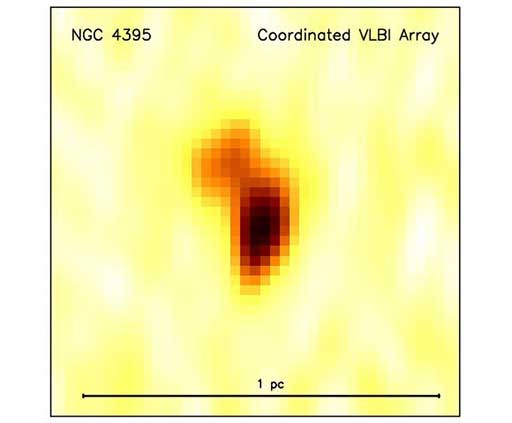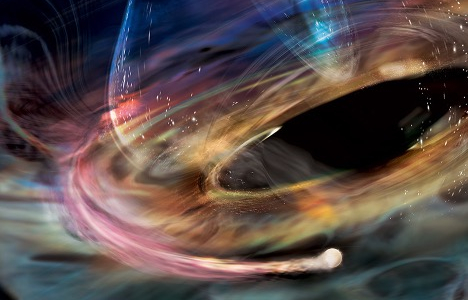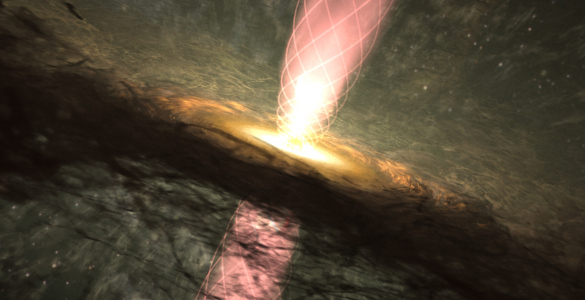Astronomers have discovered the strongest evidence yet found indicating that matter is being ejected by a medium-sized black hole, providing valuable insight on a process that may have been key to the development of larger black holes in the early Universe. The scientists combined the power of all the operational telescopes of the National Science Foundation’s National Radio Astronomy Observatory (NRAO) to peer deep into the heart of the galaxy NGC 4395, 14 million from Earth in the direction of the constellation Canes Venatici.
“We are seeing in this relatively nearby galaxy a process that may have been responsible for building intermediate-mass black holes into supermassive ones in the early Universe,” said Joan Wrobel, an NRAO scientist in Socorro, NM. Wrobel and Luis Ho of the Observatories of the Carnegie Institution of Washington in Pasadena, CA, presented their findings to the American Astronomical Society’s meeting in Seattle, WA.
are concentrations of matter so dense that not even light can escape their powerful gravitational pull.
The black hole in NGC 4395 is about 400,000 times more massive than the Sun. This puts it in a rarely-seen intermediate range between the supermassive black holes at the cores of many galaxies, which have masses millions to billions of times that of the Sun, and stellar-mass black holes only a few times more massive than the Sun. Energetic outflows of matter are common to both the supermassive and the stellar-mass black holes, but the new radio observations of NGC 4395 provided the first direct image of such a suspected outflow from an intermediate-mass black hole.
The outflows presumably are generated by little-understood processes involving a spinning disk of material being drawn toward the black hole at the disk’s center.
“An outflow from a black hole can regulate its growth by pushing back on material being drawn toward it. This is an important aspect of black hole development. Our observations offer new and unique information on how this process works for intermediate-mass black holes,” Ho said.
“Intermediate-mass black holes may have been the starting points for the supermassive black holes that we now see throughout the Universe. By studying this contemporary analog to those earlier objects, we hope to learn how the less-massive ones grew into the more-massive ones,” Wrobel explained.
The black hole in NGC 4395 was added to a small number of known intermediate-mass black holes in 2005, when a research team led by Brad Peterson of the Ohio State University calculated its mass based on ultraviolet observations. Other ultraviolet and X-ray observations gave tantalizing hints that material might be flowing outward from the black hole.
“Fortunately, this object also is detectable by radio telescopes, so we could use very high precision radio observing techniques to make extremely detailed images,” Wrobel said. Wrobel and Ho used a technique called Very Long Baseline Interferometry (VLBI), in which multiple radio-telescope antennas are used together to simulate a much larger “virtual telescope,” providing extremely great resolving power, or ability to see fine detail.
The astronomers used all of NRAO’s telescopes in their coordinated VLBI array, including the continent-wide Very Long Baseline Array (VLBA), the 27-antenna Very Large Array (VLA) in New Mexico, and the giant Robert C. Byrd Green Bank Telescope (GBT) in West Virginia. The combination of antennas spread far apart as well as the large amount of signal-collecting area in this system allowed the scientists to make a detailed image of the faint radio emission caused by fast-moving electrons in the suspected outflow from the black hole interacting with magnetic fields.
The resulting image showed the suspected outflow stretching approximately one light-year from the black hole. “This direct image bolsters the case for an outflow that was suggested by the earlier indirect evidence from the ultraviolet and X-ray observations,” Wrobel said.
“By measuring the length of this suspected outflow, we offer a unique constraint on theoretical models for how intermediate-mass black holes operate,” Ho said.
The National Radio Astronomy Observatory is a facility of the National Science Foundation, operated under cooperative agreement by Associated Universities, Inc.
Contact:
Dave Finley, Public Information Officer
Socorro, NM
(505) 835-7302
dfinley@nrao.edu











